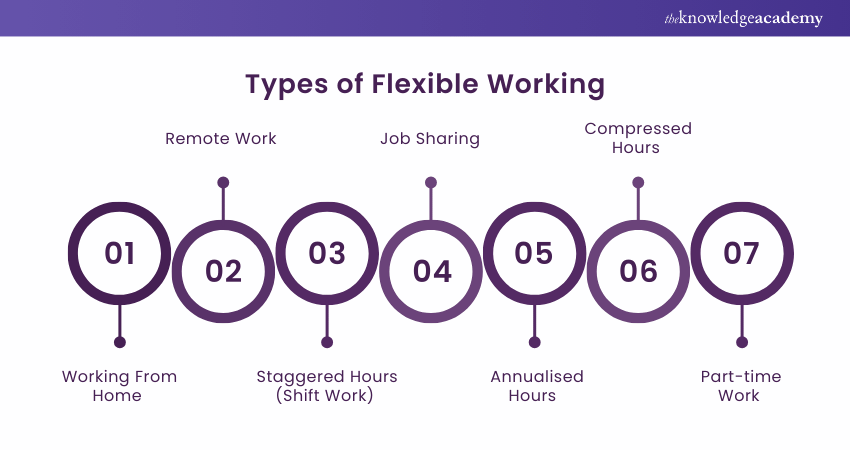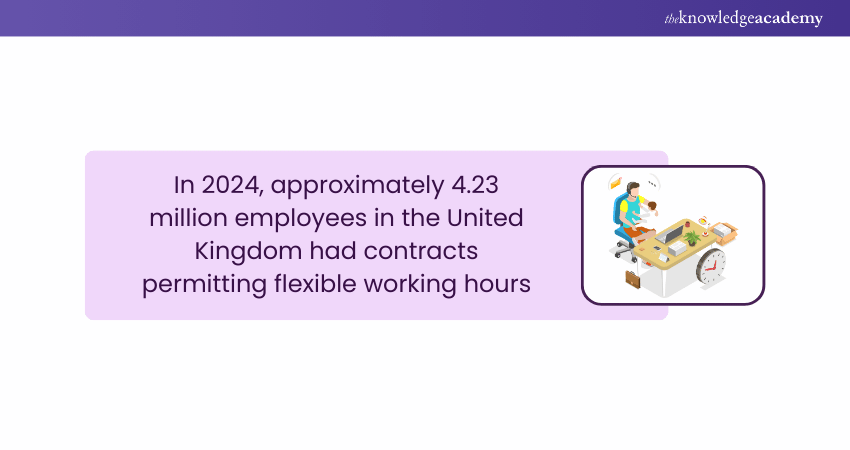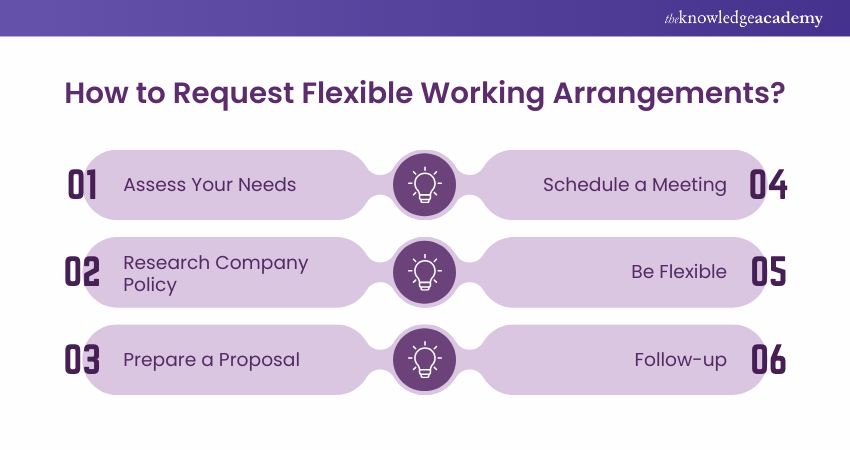We may not have the course you’re looking for. If you enquire or give us a call on + 1-866 272 8822 and speak to our training experts, we may still be able to help with your training requirements.
Training Outcomes Within Your Budget!
We ensure quality, budget-alignment, and timely delivery by our expert instructors.

Imagine being able to set your own hours or choose where you work each day. Flexible Working lets you adjust your schedule to fit your life, not the other way around. It’s a shift from the traditional 9-to-5, offering more freedom and control over when and where you work.
This setup can help reduce stress, boost productivity, and improve work-life balance. More and more companies now recognise its benefits, embracing flexible options to support their teams. For many, Flexible Working is no longer just a perk—it’s becoming the future of work. Keep reading this blog to learn more about Flexible Working.
Table of Contents
1) Understanding What is Flexible Working?
2) Types of Flexible Working
3) Advantages of Flexible Working
4) Disadvantages of Flexible Working
5) How to Request Flexible Working Arrangements?
6) Conclusion
Understanding What is Flexible Working?
Flexible Working lets employees choose their own working hours and patterns. This may involve working from home, part-time, or compressed hours instead of the typical 9-to-5 schedule. It's becoming more popular because it benefits both employees and employers.
Flexible Working boosts productivity, reduces absence levels, and improves work-life balance. It also helps attract and keep talented staff since more people want Flexible Work options.
Types of Flexible Working
There are many ways to make work arrangements more flexible. Here are common types of Flexible Working policies:

Working From Home
Employees can work from home when their job allows it, like a Software Engineer. For example, they might work from home two days a week. The COVID-19 pandemic made this option more common.
Remote Work
Some employees may work fully remotely, never going to the office. This should be clearly stated in their contract, which is different from working from home occasionally.
Staggered Hours (Shift Work)
Employees have different start, break, and finish times. Common in shift work like factory jobs, where not everyone works the same hours.
Job Sharing
Two or more employees share the same job, each working part-time. For example, one employee works Mondays and Wednesdays, and the other works Tuesdays, Thursdays, and Fridays. They function as one full-time employee for the company.
Annualised Hours
Employees work a set number of hours per year, with flexibility on when they work those hours. Core weekly hours may still be agreed upon.
Compressed Hours
Employees maintain full-time hours (e.g., 40 hours a week) but work those hours on fewer days, like four 10-hour days instead of five 8-hour days.
Part-time Work
Employees work fewer hours than the typical full-time schedule (usually 40 hours a week). Part-time can be any number of hours below full-time.
Take control of your schedule! Register for our Time Management Training to make every minute count.
Advantages of Flexible Working
Flexible Working offers benefits for employers and employees. Let's explore the benefits for each party.
Benefits for Employees
a) Work-life Balance: Flexible Working allows employees to balance their work with their personal life, improving work-life balance.
b) Reduced Commute: Policies like working from home or choosing to start and finish times help employees avoid long or busy commutes.
c) Family Time: Parents and carers have more time and freedom to care for their dependents while remaining employed.
d) Autonomy and Trust: More freedom and autonomy make employees feel trusted and valued by their employers.
e) Flexitime Benefits: Employees don’t need to take annual leave for appointments or errands, saving holiday days for actual vacations.
f) Reduced Stress: Increased flexibility can reduce pressure on employees, helping prevent overworking and burnout.
g) Cost Savings: It can save employees money on childcare costs and commuting expenses.

Benefits for Employers
a) Employer Branding: Offering Flexible Working arrangements boosts employer branding, as flexibility is a sought-after benefit.
b) Attracting Talent: Flexible Working makes your company more appealing and accessible to a broader range of candidates, including single parents.
c) Employee Satisfaction: Flexible Work improves employee happiness, satisfaction, and productivity. This in turn enhances employee retention.
d) Positive Culture: Flexibility leads to a more positive company culture and a more engaged workforce.
Disadvantages of Flexible Working
While flexibility in working has many advantages, there are a few downsides to consider as an employer:
a) Work Distribution: Some employees might misuse their newfound freedom. While many will feel empowered and become more productive, some may put in less effort.
b) Time Constraint: Developing and instituting fair, clear Flexible Working policies requires time.
c) Lack of Communication: Moving from a central work location to individual schedules might affect office culture and team spirit. Some employees might struggle to connect with fully remote colleagues.
To balance flexibility and office culture, consider hybrid working arrangements, which combine freedom with some structure. This helps maintain team cohesion while offering flexibility.
Invest in yourself! Join our Personal Development Courses to grow your skills and reach new heights.
How to Request Flexible Working Arrangements?
Requesting Flexible Working arrangements can help improve your work-life balance and productivity. Here's how you can make a successful request:

a) Assess Your Needs: Identify why you need Flexible Working arrangements. Understand how it will benefit your productivity and work-life balance.
b) Research Company Policy: Understand your company's policy on Flexible Working. Check if there are any existing guidelines or procedures.
c) Prepare a Proposal: Create a detailed proposal explaining your request, how it will work, and how it benefits both you and the company.
d) Schedule a Meeting: Arrange a meeting with your manager to discuss your request. Prepare to address questions and offer solutions to any concerns.
e) Be Flexible: Show willingness to compromise and adapt your proposal based on feedback from your manager.
f) Follow-up: After the meeting, follow up with a summary of your discussion and any agreed-upon actions. Keep track of the progress and any necessary adjustments.
Conclusion
Flexible Working allows employees to choose their working hours and patterns, such as working from home, part-time, or compressed hours. This approach enhances work-life balance and boosts productivity. It also attracts talent by offering a more adaptable and supportive work environment for both employees and employers.
Ready to be your own boss? Join our Self-Employment Training now and take control of your career!
Frequently Asked Questions

A Flexible Work schedule is vital for enhancing work-life balance, reducing stress, and boosting productivity. It also attracts and retains talent, making businesses more competitive.

Employees desire options like remote work, flexible hours, and part-time roles. They also value compressed workweeks and the ability to balance work with personal responsibilities.

The Knowledge Academy takes global learning to new heights, offering over 30,000 online courses across 490+ locations in 220 countries. This expansive reach ensures accessibility and convenience for learners worldwide.
Alongside our diverse Online Course Catalogue, encompassing 19 major categories, we go the extra mile by providing a plethora of free educational Online Resources like News updates, Blogs, videos, webinars, and interview questions. Tailoring learning experiences further, professionals can maximise value with customisable Course Bundles of TKA.

The Knowledge Academy’s Knowledge Pass, a prepaid voucher, adds another layer of flexibility, allowing course bookings over a 12-month period. Join us on a journey where education knows no bounds.

The Knowledge Academy offers various Personal Development Courses, including Self-Employment Training, Time Management Training and Attention Management Training. These courses cater to different skill levels, providing comprehensive insights into the How to Become Self-Employed.
Our Business Skills Blogs cover a range of topics related to Flexible Working, offering valuable resources, best practices, and industry insights. Whether you are a beginner or looking to advance your skills in Personal Development, The Knowledge Academy's diverse courses and informative blogs have you covered.
Upcoming Business Skills Resources Batches & Dates
Date
 Self-Employment Training
Self-Employment Training
Fri 13th Dec 2024
Fri 10th Jan 2025
Fri 14th Feb 2025
Fri 11th Apr 2025
Fri 23rd May 2025
Fri 8th Aug 2025
Fri 26th Sep 2025
Fri 21st Nov 2025







 Top Rated Course
Top Rated Course



 If you wish to make any changes to your course, please
If you wish to make any changes to your course, please


